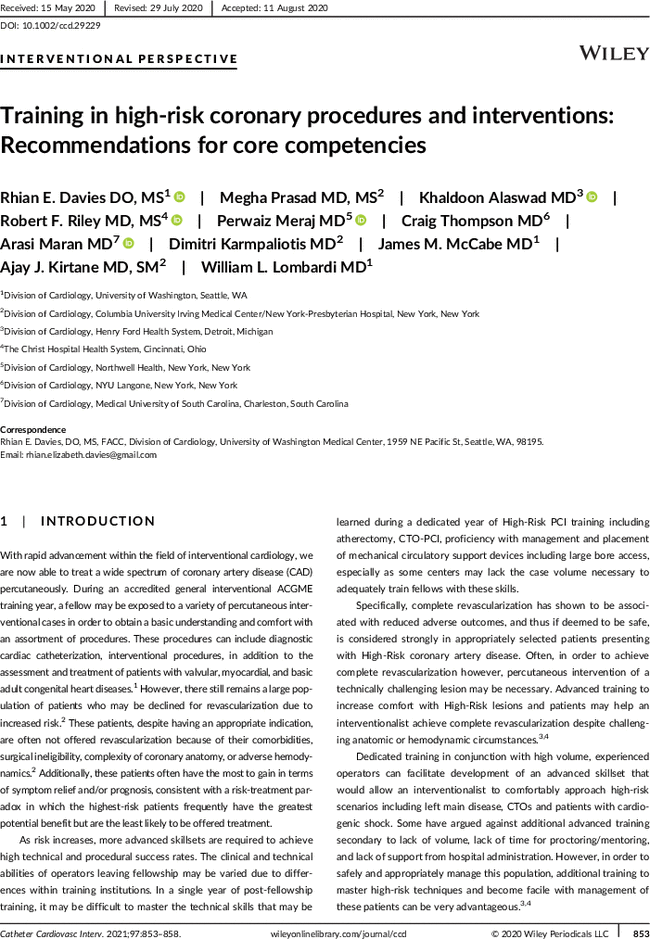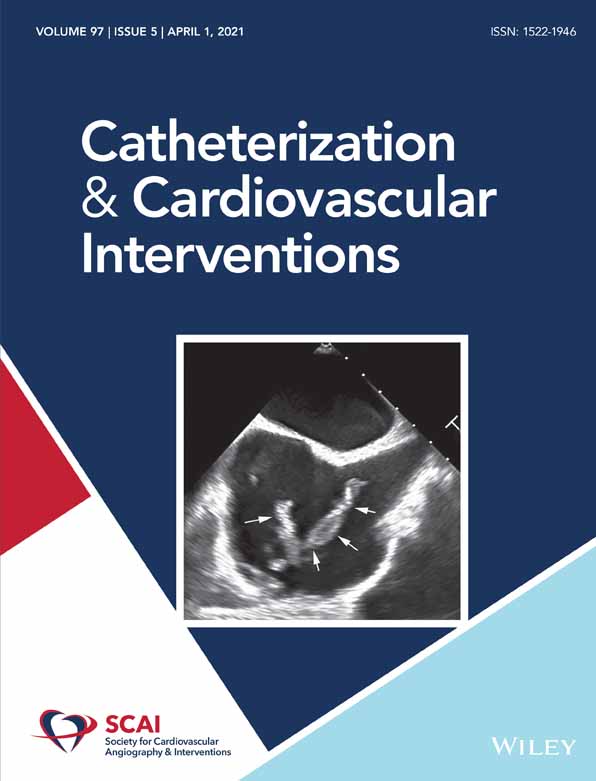Training in high-risk coronary procedures and interventions: Recommendations for core competencies
Corresponding Author
Rhian E. Davies DO, MS
Division of Cardiology, University of Washington, Seattle, WA, USA
Correspondence
Rhian E. Davies, DO, MS, FACC, Division of Cardiology, University of Washington Medical Center, 1959 NE Pacific St, Seattle, WA, 98195.
Email: [email protected]
Search for more papers by this authorMegha Prasad MD, MS
Division of Cardiology, Columbia University Irving Medical Center/New York-Presbyterian Hospital, New York, New York, USA
Search for more papers by this authorKhaldoon Alaswad MD
Division of Cardiology, Henry Ford Health System, Detroit, Michigan, USA
Search for more papers by this authorRobert F. Riley MD, MS
The Christ Hospital Health System, Cincinnati, Ohio, USA
Search for more papers by this authorPerwaiz Meraj MD
Division of Cardiology, Northwell Health, New York, New York, USA
Search for more papers by this authorCraig Thompson MD
Division of Cardiology, NYU Langone, New York, New York, USA
Search for more papers by this authorArasi Maran MD
Division of Cardiology, Medical University of South Carolina, Charleston, South Carolina, USA
Search for more papers by this authorDimitri Karmpaliotis MD
Division of Cardiology, Columbia University Irving Medical Center/New York-Presbyterian Hospital, New York, New York, USA
Search for more papers by this authorJames M. McCabe MD
Division of Cardiology, University of Washington, Seattle, WA, USA
Search for more papers by this authorAjay J. Kirtane MD, SM
Division of Cardiology, Columbia University Irving Medical Center/New York-Presbyterian Hospital, New York, New York, USA
Search for more papers by this authorWilliam L. Lombardi MD
Division of Cardiology, University of Washington, Seattle, WA, USA
Search for more papers by this authorCorresponding Author
Rhian E. Davies DO, MS
Division of Cardiology, University of Washington, Seattle, WA, USA
Correspondence
Rhian E. Davies, DO, MS, FACC, Division of Cardiology, University of Washington Medical Center, 1959 NE Pacific St, Seattle, WA, 98195.
Email: [email protected]
Search for more papers by this authorMegha Prasad MD, MS
Division of Cardiology, Columbia University Irving Medical Center/New York-Presbyterian Hospital, New York, New York, USA
Search for more papers by this authorKhaldoon Alaswad MD
Division of Cardiology, Henry Ford Health System, Detroit, Michigan, USA
Search for more papers by this authorRobert F. Riley MD, MS
The Christ Hospital Health System, Cincinnati, Ohio, USA
Search for more papers by this authorPerwaiz Meraj MD
Division of Cardiology, Northwell Health, New York, New York, USA
Search for more papers by this authorCraig Thompson MD
Division of Cardiology, NYU Langone, New York, New York, USA
Search for more papers by this authorArasi Maran MD
Division of Cardiology, Medical University of South Carolina, Charleston, South Carolina, USA
Search for more papers by this authorDimitri Karmpaliotis MD
Division of Cardiology, Columbia University Irving Medical Center/New York-Presbyterian Hospital, New York, New York, USA
Search for more papers by this authorJames M. McCabe MD
Division of Cardiology, University of Washington, Seattle, WA, USA
Search for more papers by this authorAjay J. Kirtane MD, SM
Division of Cardiology, Columbia University Irving Medical Center/New York-Presbyterian Hospital, New York, New York, USA
Search for more papers by this authorWilliam L. Lombardi MD
Division of Cardiology, University of Washington, Seattle, WA, USA
Search for more papers by this author
CONFLICT OF INTEREST
Khaldoon Alaswad Consultant and speaker for Boston Scientific, Abbott Cardiovascular, Teleflex, and CSI; Dimitrios Karmpaliotis Honoraria: Abbott Vascular, Boston Scientific, Abiomed Equity: Saranas, Soundbite, Traverse Vascular; Robert Riley Speaking honoraria from Boston Scientific, Medtronic, and Asahi Intec.; James McCabe CSI, Teleflex, Boston Scientific; Ajay Kirtane Institutional funding to Columbia University and/or Cardiovascular Research Foundation from Medtronic, Boston Scientific, Abbott Vascular, Abiomed, CSI, CathWorks, Siemens, Philips, ReCor Medical. In addition to research grants, institutional funding includes fees paid to Columbia University and/or Cardiovascular Research Foundation for speaking engagements and/or consulting. Personal: Travel Expenses/Meals from Medtronic, Boston Scientific, Abbott Vascular, Abiomed, CSI, CathWorks, Siemens, Philips, ReCor Medical, Chiesi, OpSens, Zoll, and Regeneron.
REFERENCES
- 1Competencies: American College of Cardiology. 2020. https://www.acc.org/education-and-meetings/products-and-resources/competencies.
- 2Kirtane AJ, Doshi D, Leon MB, et al. Treatment of higher-risk patients with an indication for revascularization. Circulation. 2016; 134(5): 422-431. https://doi.org/10.1161/CIRCULATIONAHA.116.022061.
- 3Brilakis ES, Banerjee S, Karmpaliotis D, et al. Procedural outcomes of chronic total occlusion percutaneous coronary intervention: a report from the NCDR (National Cardiovascular Data Registry). JACC Cardiovasc Interv. 2015; 8(2): 245-253.
- 4Valle JA, Tamez H, Abbott JD, et al. Contemporary use and trends in unprotected left main coronary artery percutaneous coronary intervention in the United States. JAMA Cardiol. 2019; 4(2): 100. https://doi.org/10.1001/jamacardio.2018.4376.
- 5Ahmad Y, Howard JP, Arnold AD, et al. Mortality after drug-eluting stents vs. coronary artery bypass grafting for left main coronary artery disease: a meta-analysis of randomized controlled trials. Eur Heart J. 2020; 4134: 3228-3235.
- 6Xu B, Redfors B, Yang Y, et al. Impact of operator experience and volume on outcomes after left Main coronary artery percutaneous coronary intervention. JACC Cardiovasc Interv. 2016; 9(20): 2086–93.
- 7Chen S-L, Zhang J-J, Han Y, et al. Double kissing crush versus provisional stenting for left main distal bifurcation lesions: DKCRUSH-V randomized trial. J Am Coll Cardiol. 2017; 70(21): 2605-2617.
- 8Farooq V, Serruys PW, Bourantas CV, et al. Quantification of incomplete revascularization and its association with five-year mortality in the synergy between percutaneous coronary intervention with Taxus and cardiac surgery (SYNTAX) trial validation of the residual SYNTAX score. Circulation. 2013; 128(2): 141-151.
- 9Généreux P, Palmerini T, Caixeta A, et al. Quantification and impact of untreated coronary artery disease after percutaneous coronary intervention: the residual SYNTAX (synergy between PCI with Taxus and cardiac surgery) score. J Am Coll Cardiol. 2012; 59(24): 2165-2174.
- 10Moussa I, Ellis SG, Jones M, et al. Impact of coronary culprit lesion calcium in patients undergoing paclitaxel-eluting stent implantation (a TAXUS-IV sub study). Am J Cardiol. 2005; 96(9): 1242-1247.
- 11Onuma Y, Tanimoto S, Ruygrok P, et al. Efficacy of everolimus eluting stent implantation in patients with calcified coronary culprit lesions: two-year angiographic and three-year clinical results from the SPIRIT II study. Catheter Cardiovasc Interv. 2010; 76(5): 634-642.
- 12Clavijo LC, Steinberg DH, Torguson R, et al. Sirolimus-eluting stents and calcified coronary lesions: clinical outcomes of patients treated with and without rotational atherectomy. Catheter Cardiovasc Interv. 2006; 68(6): 873-878. https://doi.org/10.1002/ccd.20615.
- 13Benezet J, Diaz de la Llera L, Cubero J, et al. Drug-eluting stents following rotational atherectomy for heavily calcified coronary lesions: long-term clinical outcomes. J Invasive Cardiol. 2011; 23(1): 28-32.
- 14Arora S, Panaich SS, Patel N, et al. Coronary atherectomy in the United States (from a Nationwide inpatient sample). Am J Cardiol. 2016; 117: 555-562. https://doi.org/10.1016/j.amjcard.2015.11.041.
- 15Hannan EL, Zhong Y, Jacobs AK, et al. Patients with Chronic Total Occlusions Undergoing Percutaneous Coronary Interventions: Characteristics, Success, and Outcomes. Circ Cardiovasc Interv. 2016; 9(5): 1–9. https://doi.org/10.1161/CIRCINTERVENTIONS.116.003586.
- 16Sapontis J, Salisbury AC, Yeh RW, et al. Early procedural and health status outcomes after chronic Total occlusion angioplasty. JACC Cardiovasc Interv. 2017; 10(15): 1523-1534.
- 17Tajti P, Karmpaliotis D, Alaswad K, et al. The hybrid approach to chronic total occlusion percutaneous coronary intervention. JACC Cardiovasc Interv. 2018; 11(14): 1325-1335.
- 18Werner GS, Martin-Yuste V, Hildick-Smith D, et al. A randomized multicentre trial to compare revascularization with optimal medical therapy for the treatment of chronic total coronary occlusions. Eur Heart J. 2018; 39(26): 2484-2493.
- 19Maeremans J, Walsh S, Knaapen P, et al. The hybrid algorithm for treating chronic total occlusions in Europe. J Am Coll Cardiol. 2016; 68(18): 1958-1970.
- 20Christopoulos G, Karmpaliotis D, Alaswad K, et al. Application and outcomes of a hybrid approach to chronic total occlusion percutaneous coronary intervention in a contemporary multicenter US registry. Int J Cardiol. 2015; 198: 222-228.
- 21Tsai TT, Stanislawski MA, Shunk KA, et al. Contemporary Incidence, Management, and Long-Term Outcomes of Percutaneous Coronary Interventions for Chronic Coronary Artery Total Occlusions: Insights From the VA CART Program. JACC: Cardiovascular Interventions. 2017; 10(9): 866–875.
- 22Wilson WM, Walsh SJ, Yan AT, et al. Hybrid approach improves success of chronic total occlusion angioplasty. Heart. 2016; 102(18): 1486-1493.
- 23Habara M, Tsuchikane E, Muramatsu T, et al. Comparison of percutaneous coronary intervention for chronic total occlusion outcome according to operator experience from the Japanese retrograde summit registry. Catheter Cardiovasc Interv. 2016; 87(6): 1027-1035. https://doi.org/10.1002/ccd.26354.
- 24Råmunddal T, Hoebers LP, Henriques JPS, et al. Prognostic impact of chronic Total occlusions. JACC Cardiovasc Interv. 2016; 9(15): 1535-1544.
- 25Sharma V, Jadhav ST, Harcombe AA, et al. Impact of proctoring on success rates for percutaneous revascularisation of coronary chronic total occlusions. Open Heart. 2015; 2(1):e000228. https://doi.org/10.1136/openhrt-2014-000228.
- 26Riley RF, Walsh SJ, Kirtane AJ, et al. Algorithmic solutions to common problems encountered during chronic total occlusion angioplasty: the algorithms within the algorithm. Catheter Cardiovasc Interv. 2019; 93(2): 286-297. https://doi.org/10.1002/ccd.27987.
- 27Mohandes M, Guarinos J, Sans J, et al. Intravascular ultrasound in percutaneous coronary intervention for chronic total occlusion. Iran Cardiovasc Res J. 2010; 4(3): 101-106.
- 28Kim B-K, Shin D-H, Hong M-K, et al. Clinical impact of intravascular ultrasound-guided chronic total occlusion intervention with zotarolimus-eluting versus biolimus-eluting stent implantation: randomized study. Circ Cardiovasc Interv. 2015; 8(7):e002592.
- 29Perera D, Stables R, Thomas M, et al. Elective intra-aortic balloon counterpulsation during high-risk percutaneous coronary intervention: a randomized controlled trial. JAMA. 2010; 304(8): 867. https://doi.org/10.1001/jama.2010.1190.
- 30O'Neill WW, Kleiman NS, Moses J, et al. A prospective, randomized clinical trial of hemodynamic support with impella 2.5 versus intra-aortic balloon pump in patients undergoing high-risk percutaneous coronary intervention: the PROTECT II study. Circulation. 2012; 126(14): 1717-1727.
- 31Cohen MG, Ghatak A, Kleiman NS, et al. Optimizing rotational atherectomy in high-risk percutaneous coronary interventions: insights from the PROTECT ΙΙ study. Catheter Cardiovasc Interv. 2014; 83: 1057-1064.
- 32Seto AH, Abu-Fadel MS, Sparling JM, et al. Real-time ultrasound guidance facilitates femoral arterial access and reduces vascular complications: FAUST (femoral arterial access with ultrasound trial). JACC Cardiovasc Interv. 2010; 3(7): 751-758.
- 33Ball WT, Sharieff W, Jolly SS, et al. Characterization of operator learning curve for transradial coronary interventions. Circulation. 2011; 4: 336-341. https://doi.org/10.1161/CIRCINTERVENTIONS.110.960864.
- 34Riley RF, Sapontis J, Kirtane AJ, et al. Prevalence, predictors, and health status implications of periprocedural complications during coronary chronic total occlusion angioplasty. EuroIntervention. 2018; 14(11): e1199-e1206.




